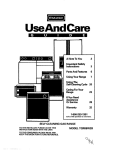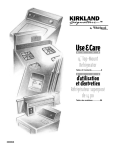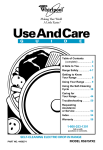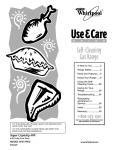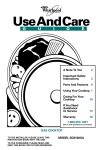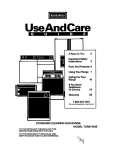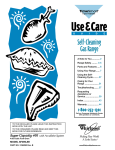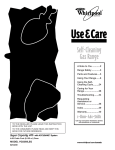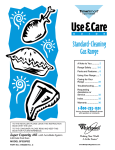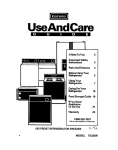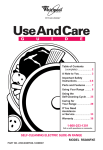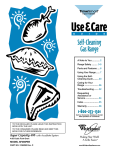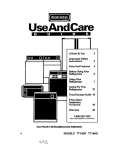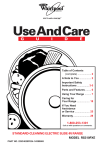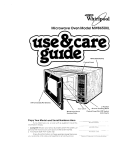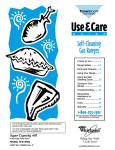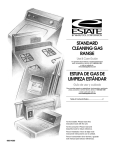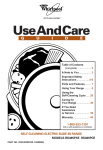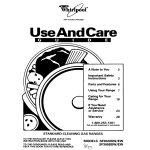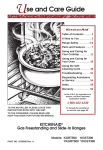Download Whirlpool SS385PEE User's Manual
Transcript
UseAndCare G U I D E A Note to You ............................ 2 Important Safety Instructions ................................ 2 Parts and Features .................... 5 Using Your Range ..................... 6 Using the surface burners ....... 6 Positioning racks and pans ..... 8 For best air circulation ............. 9 The electronic oven control ..... 9 Setting the clock .................... 10 Using the electronic Minute Timer ......................... 10 Baking/roasting ..................... 12 Adjusting the oven temperature control ............... 13 Broiling .................................. 14 Energy saving tips ................. 16 Using the electronic MEALTIMER™ control .......... 16 The oven vent........................ 20 The storage drawer ............... 20 The anti-tip chain ................... 21 Using the Self-Cleaning Cycle ................. 22 Caring for Your Range ....................................... 26 If You Need Assistance or Service ................................. 32 Warranty ................................... 36 1-800-253-1301 Call us with questions or comments. SELF-CLEANING GAS RANGE TO THE INSTALLER: PLEASE LEAVE THIS INSTRUCTION BOOK WITH THE UNIT. TO THE CONSUMER: PLEASE READ AND KEEP THIS BOOK FOR FUTURE REFERENCE. PART NO. 229C4020P030-2/4389869 Rev. A MODEL SS385PEE A Note to You Thank you for buying a WHIRLPOOL® appliance. The Whirlpool Brand is committed to designing quality products that consistently perform for you to make your life easier. To ensure that you enjoy years of trouble-free operation, we developed this Use and Care Guide. It is full of valuable information about how to operate and maintain your appliance properly and safely. Please read it carefully. Also, please complete and mail the Product Registration Card provided with your appliance. The card helps us notify you about any new information on your appliance. Please record your model’s information. Whenever you call to request service for Model Number __________________________ your appliance, you need to know your complete model number and serial number. Serial Number __________________________ You can find this information on the model Purchase Date __________________________ and serial number label/plate (see diagram in the “Parts and Features” section). Dealer Name ___________________________ Please also record the purchase date of Dealer Address _________________________ your appliance and your dealer’s name, Dealer Phone ___________________________ address, and telephone number. Keep this book and the sales slip together in a safe place for future reference. It is important for you to save your sales receipt showing the date of purchase. Proof of purchase will assure you of in-warranty service. Our Consumer Assistance Center number is toll-free. 1-800-253-1301 WARNING: If the information in this manual is not followed exactly, a fire or explosion may result causing property damage, personal injury or death. – Do not store or use gasoline or other flammable vapors and liquids in the vicinity of this or any other appliance. – WHAT TO DO IF YOU SMELL GAS • Do not try to light any appliance. • Do not touch any electrical switch; do not use any phone in your building. • Immediately call your gas supplier from a neighbor’s phone. Follow the gas supplier’s instructions. • If you cannot reach your gas supplier, call the fire department. – Installation and service must be performed by a qualified installer, service agency or the gas supplier. 2 Important Safety Instructions Your safety and the safety of others is very important. We have provided many important safety messages in this manual and on your appliance. Always read and obey all safety messages. This is the safety alert symbol. This symbol alerts you to hazards that can kill or hurt you and others. All safety messages will be preceded by the safety alert symbol and the word “DANGER” or “WARNING.” These words mean: wDANGER You will be killed or seriously injured if you don’t follow instructions. wWARNING You can be killed or seriously injured if you don’t follow instructions. All safety messages will identify the hazard, tell you how to reduce the chance of injury, and tell you what can happen if the instructions are not followed. wWARNING Tip Over Hazard A child or adult can tip the range and be killed. Connect anti-tip chain to bracket on rear of range. Reconnect the anti-tip chain, if the range is moved. See the installation instructions for details. Failure to follow these instructions can result in death or serious burns to children and adults. Anti-Tip Chain Making sure the anti-tip chain is installed: • Slide range forward about 4 inches. • Look for the anti-tip chain securely attached to floor or wall. • Make sure chain is tight. • Slide range back into position. 3 RANGE SAFETY IMPORTANT SAFETY INSTRUCTIONS WARNING: To reduce the risk of fire, electrical shock, injury to persons, or damage when using the range, follow basic precautions, including the following: • WARNING – TO REDUCE THE RISK OF TIPPING OF THE RANGE, THE RANGE MUST BE SECURED BY PROPERLY INSTALLED ANTI-TIP DEVICES. TO CHECK IF THE DEVICES ARE INSTALLED PROPERLY, SLIDE RANGE FORWARD, LOOK FOR ANTI-TIP CHAIN SECURELY ATTACHED TO FLOOR OR WALL, MAKE SURE CHAIN IS TIGHT, AND SLIDE RANGE BACK INTO POSITION. • CAUTION – Do not store items of interest to children in cabinets above a range or on the backguard of a range – children climbing on the range to reach items could be seriously injured. • Proper Installation – The range, when installed, must be electrically grounded in accordance with local codes or, in the absence of local codes, with the National Electrical Code, ANSI/NFPA 70. Be sure the range is properly installed and grounded by a qualified technician. • This range is equipped with a three-prong grounding plug for your protection against shock hazard and should be plugged directly into a properly grounded receptacle. Do not cut or remove the grounding prong from this plug. • Disconnect the electrical supply before servicing the appliance. • Never Use the Range for Warming or Heating the Room. • Injuries may result from the misuse of appliance doors or drawers such as stepping, leaning, or sitting on the doors or drawers. • Maintenance – Keep range area clear and free from combustible materials, gasoline, and other flammable vapors and liquids. • Storage in or on the Range – Flammable materials should not be stored in an oven or near surface units. • Top burner flame size should be adjusted so it does not extend beyond the edge of the cooking utensil. For self-cleaning ranges – • Before Self-Cleaning the Oven – Remove broiler pan and other utensils. Wipe off all excessive spillage before initiating the cleaning cycle. – SAVE THESE INSTRUCTIONS – 4 Parts and Features Anti-tip chain (as shown on p. 22) Oven vent (p. 21) Surface burners, grates, and reflector pans (pp. 8, 27, 28, 30) OVEN LIGHT DELAY OVEN ON FRONT OFF HR BROIL BAKE CLEAN LOCK CLEAN STOP TIMER CANCEL REAR FRONT TIMER CLOCK ON/OFF STOP STOP TIME COOK TIME CLEAN O N BROIL BROIL AKE BAKE REAR Oven burner (not shown) Control panel (pp. 7, 10-12) Model and serial number plate (p. 2) Storage drawer (p. 21) Control panel Electronic oven control (p. 10) Surface burner markers (p. 7) REAR FRONT REAR Manual oven light switch (p. 32) FRONT OVEN LIGHT OFF DELAY OVEN ON CLEAN STOP TIMER HR BAKE CLEAN BROIL LOCK O N CANCEL TIMER ON/OFF CLOCK Left rear control knob (p. 7) Left front control knob (p. 7) Right rear control knob (p. 7) STOP TIME COOK TIME CLEAN BROIL BAKE Right front control knob (p. 7) 5 Using Your Range Using the surface burners Your range is equipped with electric ignitors. Electric ignitors automatically light the burners each time they are used. Push in control knob and turn counterclockwise to the LITE position. The clicking sound is the ignitor sparking. Visually check that burner has lit. To stop the clicking sound after the burner lights, turn the control knob to the desired cook setting. The control knob has stops for HI, MED, and LOW. However, you can set the control knob anywhere between HI and OFF. Surface burner markers The solid dot in the surface burner marker shows which surface burner is turned on by that knob. wWARNING Fire Hazard Do not let the burner flame extend beyond the edge of the pan. Turn off all controls when not cooking. Failure to follow these instructions can result in death or fire. 6 Push in and turn counterclockwise U SIN G YO U R RAN G E Burner heat settings Cookware tips Use correct burner heat settings. If the heat setting is too high, it can: • Char bacon and cause curling. • Make eggs tough and crisp at the edges. • Toughen liver, fish, and seafood. • Scorch delicate sauces and custards. • Cause a boilover. No one brand of cookware is best for all people. Knowing something about pan materials and construction will help you select the correct cookware for your needs. • For best results and greater fuel efficiency, use only flat-bottomed cookware in good condition. • The pan should have straight sides and a tight-fitting lid. • Choose medium to heavy gauge (thickness) pans that are fairly lightweight. • The pan material (metal or glass) affects how fast heat transfers from the surface burner through the pan material and how evenly heat spreads over the pan bottom. Choose pans that provide the best cooking results. • Handles should be made of a sturdy, heatresistant material and be securely attached to the pan. • Pans should be easy to clean. Check to be sure there are no crevices, rough edges, or areas where food might collect. • Be sure pans do not tip, whether they are full or empty. • Use cookware only as it was intended to be used and follow pan instructions. This is very important for glass cookware because some should be used only in the oven. Other pans are marked as flameware and may be used on the surface burners. Until you get used to the settings, use the following as a guide. For best results, start cooking at the high setting; then turn the control knob down to continue cooking. NOTE: Do not cook with the control knob in the LITE position. In case of a prolonged power failure Surface burners can be manually lighted. Hold a lit match near a burner and turn the control knob to the LITE position. After the burner lights, turn the control knob to the desired setting. SETTING LITE HI RECOMMENDED USE • To light the burner. After the burner lights, turn control knob to a desired setting to stop the clicking of the ignitor. • To start food cooking. • To bring liquid to a boil. MED • To maintain a slow boil. • To fry poultry or meat. • To make pudding, sauce, or gravy. LOW • To keep food warm. • To melt chocolate or butter. • To stew or steam food. • To simmer food. NOTE: Do not leave empty cookware, or cookware which has boiled dry, on a hot surface burner. The cookware could overheat causing damage to the cookware or cooking product. Home canning information The larger diameter of most water-bath or pressure canners combined with high heat settings for long periods of time can cause damage to the cooktop. To protect your range: • For best results, use a canner which can be centered over the surface burner. center over surface unit 1" 1 inch maximum overhang 1" continued on next page 7 U SI N G Y O U R RANGE • Use flat-bottomed canners on all types of cooktops, especially ceramic glass. Canners with rippled or ridged bottoms do not allow good contact with the surface. • Do not place canner on two surface burners at the same time. • Alternate use of the surface cooking areas between batches or prepare small batches at a time. • Start with hot water. This reduces the time the control is set on high. Reduce heat setting to lowest position needed to maintain a boil or required pressure levels in a pressure canner. • Keep reflector pans clean for best heat reflection. • Refer to your canner manual for specific instructions. For up to date information on canning, contact your local US Government Agricultural Department Extension Office or companies who manufacture home canning products. Positioning racks and pans To remove racks: Bakeware tips 1. Pull rack toward you. 2. Tilt up front end. 3. Pull rack out. • When baking with insulated cookie sheets or baking pans, place them in the bottom third of the oven. You may need to increase the recommended baking times, so test for doneness before removing from the oven. • When using ovenproof glassware or dark bakeware, reduce the oven temperature by 25°F but use the same baking time. Because these pans absorb heat, producing darker bottom browning and crispier crusts, place the rack in the center of the oven. To replace racks: 1. 2. 3. 4. Place rack on rack guides. Tilt up front end. Push rack in until it clears the stop. Lower front and push rack in the rest of the way. General guidelines • Before turning on the oven place oven racks where you need them. • Be sure the rack(s) is level. • Use pot holders or oven mitts to protect your hands if rack(s) must be moved while the oven is hot. • For baking/roasting with 1 rack, place the rack so the top of the food will be centered in the oven. • When baking/roasting on 2 racks, position racks in oven to allow good circulation of air around all the food. • Do not place items on the oven door when it is open. Rack placement for specific foods: FOOD RACK POSITION Frozen pies, large roasts, turkeys, angel food cake 1st or 2nd rack guide from bottom Bundt cakes, most quick breads, yeast breads, casseroles, meats 2nd rack guide from bottom Cookies, biscuits, muffins, cakes, nonfrozen pies 2nd or 3rd rack guide from bottom NOTE: For recommended rack placement when broiling, see “Broiling tips” later in this section. 8 U SIN G YO U R RAN G E For best air circulation Hot air must circulate around the pans in the oven for even heat to reach all parts of the oven. This results in better baking. • Place the pans so that one is not directly over the other. • For best results, allow 11⁄2 to 2 inches (4 to 5 cm) of space around each pan and between pans and oven walls. • Use only one cookie sheet in the oven at a time. Use the following as a guide to determine where to place the pans: 1 pan Place in the center of the oven rack. 2 pans Place in opposite corners of the oven rack. 3 or 4 pans Place in opposite corners on each oven rack. Stagger pans so no pan is directly over another. The electronic oven control Off/cancel pad OFF Electronic display DELAY OVEN ON CLEAN STOP TIMER Increase/decrease pads HR BAKE CLEAN BROIL LOCK O N CANCEL TIMER ON/OFF CLOCK STOP TIME COOK TIME CLEAN BROIL BAKE Timer Clock Stop Cook Clean Broil Bake on/off pad time time pad pad pad pad pad pad Display/clock • When you first plug in the range, the entire display appears followed by a flashing time-of-day. If, after you set the clock (see “Setting the clock” on the next page), the display flashes, your electricity was off for a while. Reset the clock. • When you are not using the oven, the control is an accurate clock. • When you are using the oven or Minute Timer, the display will show times, temperature settings, and the command pads that have been pressed. • When showing the time of day, the display will show the hour and minutes. • When you are using the Minute Timer, the display will show minutes and seconds for time less than 1 hour and hours and minutes for time over 1 hour. • When you are using Cook Time and/or Stop Time, the display will show hours and minutes. Command pads The command pads tell the oven what to do and in what order. A few examples: – Clock tells the oven you are going to set the clock. – Off/Cancel tells the oven to turn off. – Increase/Decrease pads change time or temperature. Press a pad briefly to change time or temperature by a small amount. Press and hold a pad to change time or temperature by a larger amount. Each command pad (except Off/Cancel) has its own Indicator Light. The Indicator Light comes on when you touch the command pad. 9 U SI N G Y O U R RANGE Setting the clock The clock must be set for the automatic oven timing functions to work properly. 1. Press the Clock pad. CLOCK 2. Press the “increase” (▲) or “decrease” (▼) pad until the correct time of day shows on the display. 3. Press the Off/Cancel pad. NOTES: • You cannot change time of day during a Timed Bake or the Self-Cleaning cycle. • You can see the current time of day while using another function by pressing the Clock pad. OFF CANCEL Using the electronic Minute Timer The Minute Timer does not start or stop the oven. It works like a kitchen timer. It can be set in hours and minutes up to 9 hours, 55 minutes. The Minute Timer will display minutes and seconds for settings under 1 hour and hours and minutes for time over 1 hour. 1. Press the Timer On/Off pad. 2. Press the “increase” (▲) or “decrease” (▼) pad until the correct time shows on the display. The Minute Timer will start automatically within a few seconds after you release the pad. 10 TIMER ON/OFF U SIN G YO U R RAN G E After the countdown is over, 3 short tones will sound, followed by one tone that sounds every 6 seconds until you press any other command pad. To cancel the Minute Timer: Press Timer On/Off pad for about 4 seconds until TIMER stops flashing on the display. TIMER ON/OFF Using the off/cancel pad The Off/Cancel pad will cancel any function except for the Timer function. When you press the Off/Cancel pad, the display will show the time of day or, if Minute Timer is also being used, the time remaining. OFF CANCEL Audible signals Audible signals tell you if a function is entered correctly or not. They also tell you when a cycle is completed. To shut off repeating end of timer countdown signal: 1. Press and hold the Off/Cancel pad for 10 seconds. 2. A short tone will sound to tell you the signal has been changed. Repeat Steps 1 and 2 above to turn the signal back on. 11 U SI N G Y O U R RANGE Baking/roasting NOTE: Do not attempt to light the oven burner during a power failure. See the “Important Safety Instructions” section for more information. 1. Position the rack(s) properly before turning on the oven. For further information, see “Positioning racks and pans” earlier in this section. 2. Press the Bake pad; then press the “increase” (▲) or “decrease” (▼) pad once. The last oven temperature which was set appears on the display. 3. To cook at a different temperature, use the Increase/Decrease pad(s). Press the “increase” (▲) pad to raise the temperature or the “decrease” (▼) pad to lower the temperature. Use these pads until the desired temperature shows on the small display. 4. When the oven starts to heat, “ON” and the changing temperature (starting at 100°F) will be displayed. When the oven reaches the set temperature, a tone will sound. NOTES: • If you are baking/roasting after a Self-Cleaning cycle, allow oven to cool until “LOCK” disappears. • You can change the temperature setting any time during the Bake cycle by repeating Steps 2 and 3 above. 5. When baking, preheat the oven. (Preheating is not needed when roasting.) The oven is preheated when you hear 5 short beeps. 6. Put food in the oven. During baking/ roasting, the oven burner will turn on and off to keep the oven temperature at the setting. 7. When baking/roasting is done, press the Off/Cancel pad. The time of day will show on the display and all other displays will go off. 12 BAKE OFF CANCEL U SIN G YO U R RAN G E Adjusting the oven temperature control Although your new oven is properly adjusted to provide accurate temperatures, it may cook faster or slower than your old oven. If, after using the oven for a period of time, you are not satisfied with the baking/roasting results, you can change the temperature calibration by following the steps below: NOTE: DO NOT measure the oven temperature with a thermometer. Opening the oven door will lower the oven temperature and give you an incorrect reading. Also, the thermometer temperature reading will change as your oven cycles. 1. Press the Bake pad. The Bake indicator light will flash. BAKE 2. Press the “increase” (▲) pad and set the oven temperature at 550°F. 3. Before Bake stops flashing, press and hold the Bake pad until the 2-digit display appears. BAKE 4. Release the Bake pad. The display will show the current offset temperature, for example “00,” if the temperature has not been previously adjusted. 5. Set the new offset temperature. Press either the “increase” (▲) or the “decrease” (▼) pad to raise or lower the temperature in 5°F amounts. You can set the temperature as low as -35°F cooler or as high as +35°F hotter. A minus (-) sign will appear before the number when decreasing the temperature setting to show the oven will be cooler by the displayed amount. There is no sign in front of the number when increasing the temperature setting. 6. After making the desired adjustment, press the Off/Cancel pad to complete the entry of the new offset temperature. OFF CANCEL NOTE: All Bake/Roast temperatures will now be increased or decreased by the new offset temperature until a new oven temperature is entered. For example, if 10°F is entered as the new offset temperature, the temperature will read 350°F, but will actually heat to 360°F, etc. This does not affect Broil or Clean cycles. 13 U SI N G Y O U R RANGE Broiling NOTE: See “Broiling tips” later in this section. 1. Position the rack(s) before turning the oven on. See the “Broiling rack position chart” on the next page. 2. Press the Broil pad. 3. Preheat the broiler for 5 minutes on HI before using. 4. Select LO Broil (450°F) by pressing the “increase” (▲) pad once. Select HI Broil (550°F) by pressing the “increase” (▲) pad twice. NOTES: • If you are broiling after a SelfCleaning cycle, allow oven to cool until “LOCK” disappears. • If food is cooking too fast or you want to broil slower from the start, you can change the temperature setting any time during the Broil cycle. Press the Broil pad and select the “increase” (▲) pad to change the temperature to HI or the “decrease” (▼) pad to change the temperature to LO. • Fish and chicken are some foods that may cook better if you use lower broiling temperatures. 5. After preheating, put the broiler pan and food on the rack. 6. Completely close the oven door to ensure proper broiling temperatures. 7. When broiling is done, press the Off/ Cancel pad. The time of day will show on the display and all other displays will go off. Serve food immediately and leave the broiler pan outside oven to cool during the meal for easiest cleaning. 14 BROIL BROIL OFF CANCEL U SIN G YO U R RAN G E Broiling tips • Use the broiler pan and grid for broiling. They are designed to drain excess liquid and grease away from the cooking surface to help prevent spatter or smoke. • If you broil small quantities, you may want to use a small broiler pan. They are available in the housewares section of many department stores. • Do not cover the broiler grid with foil. • To ensure adequate grease drainage, do not use cookie sheets or similar pans for broiling. • Place food about 3 inches or more from the broil burner. • For best broiling results, preheat at HI for 5 minutes. Do not preheat with broiler pan in place. • Broiling rack position determines how the burner cooks your food. The lower the position, the more broiler grid area covered. See “Broiling rack position chart” at right for more information. • To sear meat, place broiler pan at one of the higher rack positions. • Thin (3⁄4 inch) steaks may be broiled in the higher rack positions. • To cook thick (11⁄2 inch) steaks and other thick cuts of meat well done, start cooking on a lower rack position or move them to a lower rack position after searing. • After broiling, remove the broiler pan from the oven when you remove the food. Drippings will bake on the pan if you leave it in the heated oven. Broiling rack position chart RACK POSITION FROM BOTTOM FOOD 4 Rare steaks and fish 3 Medium and well-done steaks and hamburgers; well-done foods such as chicken, lobster, ham slices, and pork chops 15 U SI N G Y O U R RANGE Energy saving tips Although the energy used for cooking is usually a very small percentage of the total energy used in the home, cooking energy can be used efficiently. Here are some tips to help you save energy when using your cooking product: • Turn on the surface burner only after placing filled pan on the burner grate. • “Oven peeking” may cause heat loss, longer cooking times, and unsatisfactory baking results. Rely on your timer to keep track of the cooking time. • Plan your meals for the most efficient use of the range by cooking more than one food at a time, or baking while the oven is still hot after cooking a meal. • Keep reflector pans clean for best heat reflection. Using the electronic MEALTIMER™ control The electronic MEALTIMER control will turn the oven on and off at times you set, even when you are not around. Delayed time baking/roasting is ideal for foods which do not require a preheated oven, such as meats and casseroles. Do not use delayed time cooking for cakes, cookies, etc. – they will not rise properly. Before using the electronic MEALTIMER control, make sure the clock is set to the correct time of day. (See “Setting the clock” earlier in this section.) 16 wWARNING Food Poisoning Hazard Do not let food sit in oven more than one hour before or after cooking. Doing so can result in death, food poisoning, or sickness. U SIN G YO U R RAN G E To start baking/roasting now and stop automatically: 1. Position the oven rack(s) properly and put food in the oven. 2. Press the Cook Time pad. COOK TIME 3. Press the “increase” (▲) pad until the desired baking/roasting time shows on the display. 4. Press the Bake pad. NOTE: If this step is not done, a tone will sound. BAKE 5. Press the “increase” (▲) or “decrease” (▼) pad until the desired temperature shows on the display. 6. When the oven starts to heat, “ON” and the changing temperature (starting at 100°F) will be displayed. When the oven reaches the set temperature, 5 short beeps will sound. NOTES: • If you are baking/roasting after a Self-Cleaning cycle, allow oven to cool until “LOCK” disappears. • You can change the temperature setting any time during the Bake cycle by repeating Steps 4 and 5 above. 7. Remove food from the oven. NOTE: Even though oven shuts off automatically, the food continues cooking from internal oven heat . 17 U SI N G Y O U R RANGE To delay start and stop automatically: 1. Position the oven rack(s) properly and put food in the oven. 2. Press the Cook Time pad. COOK TIME 3. Press the “increase” (▲) or “decrease” (▼) pad until the desired length of baking/ roasting time shows on the display. (example for 3 hours) 4. Press the Stop Time pad. The time displayed will be the time of day plus the cook time. For example, if the current time of day is 2:00 and the cook time is 3 hours, the display will show 5:00. STOP TIME STOP TIME (example for 5:00 stop time, before stop time is set) 5. Press the “increase” (▲) or “decrease” (▼) pad to set the desired stop time. If you have set a 7:00 stop time and a 3-hour cook time, the oven will turn on at 4:00. NOTE: Press the Cook Time pad for 3 seconds to see the start time. STOP TIME (example for 7:00 stop time) 18 U SIN G YO U R RAN G E 6. Press the Bake pad. NOTE: If this step is not done, a tone will sound. BAKE 7. Press the “increase” (▲) or “decrease” (▼) pad until the desired temperature shows on the display. 8. At the set start time (4:00 in example on the previous page), the oven will turn on automatically. When the oven starts to heat, “ON” and the changing temperature (starting at 100°F) will be displayed. When the oven reaches the set temperature, a tone will sound. The oven will continue to cook for the programmed 3 hours and shut off automatically at 7:00. NOTES: • If you are baking/roasting after a Self-Cleaning cycle, allow oven to cool until “LOCK” disappears. • You can change the temperature setting any time during the Bake cycle by repeating Steps 6 and 7 above. 9. Remove food from the oven. NOTE: Even though the oven shuts off automatically, foods continue cooking from internal oven heat. To cancel the MEALTIMER™ control setting: • Press Off/Cancel pad to return the display to the time of day. OFF CANCEL 19 U SI N G Y O U R RANGE The oven vent wWARNING Burn Hazard Use pot holders when touching items left near oven vent. Failure to do so can result in burns. Hot air and moisture escape from the oven through a vent located at center rear of the cooktop. The vent is needed for air circulation. Do not block the vent by using extra large pans or covers. You will get poor baking/roasting results. NOTE: Never store plastics, paper, or other items that could melt or burn near the oven vent, or any of the surface burners. The storage drawer You can remove the storage drawer to make it easier to clean under the range. Use care when handling the drawer. Removing the storage drawer: 1. Empty drawer before removing. Pull drawer straight out to the first stop. Lift front and pull out to the second stop. 2. Lift back slightly and slide drawer all the way out. 20 Oven vent U SIN G YO U R RAN G E Replacing the storage drawer: 1. Fit ends of drawer slide rails into the drawer guides on both sides of opening. 2. Lift drawer front and push in until metal stops on drawer slide rails clear white stops on drawer guides. Lift drawer front again to clear second stop and slide drawer closed. Drawer slide rail The anti-tip chain The range will not tip during normal use. However, tipping can occur if you apply too much force or weight to the open door without the anti-tip chain properly secured. wWARNING Tip Over Hazard A child or adult can tip the range and be killed. Connect anti-tip chain to bracket on rear of range. Reconnect the anti-tip chain, if the range is moved. See the installation instructions for details. Failure to follow these instructions can result in death or serious burns to children and adults. Anti-Tip Chain Making sure the anti-tip chain is installed: • Slide range forward about 4 inches. • Look for the anti-tip chain securely attached to floor or wall. • Make sure chain is tight. • Slide range back into position. To verify the anti-tip chain is engaged: • Slide range forward about 4 inches and carefully try to tilt forward. If anti-tip chain is attached to floor or wall correctly, range should not tilt forward to the point of tipping. • See Installation Instructions for further details. Bracket factory location Baseboard Chain Chain Washer and screw Base Plate 21 Using the Self-Cleaning Cycle The Self-Cleaning cycle saves you from the toil and mess that often come with hand-cleaning the oven interior. Like the other functions of your oven, you operate the Self-Cleaning cycle with the easy-to-use electronic control. Please review the instructions in this section to keep your oven spotless. wWARNING Burn Hazard Do not touch the oven during the Self-Cleaning cycle. Keep children away from oven during Self-Cleaning cycle. Do not use commercial oven cleaners in your oven. Failure to follow these instructions can result in burns, or illness from inhaling dangerous fumes. Before you start Before you start the Self-Cleaning cycle, make sure you: • Hand-clean the areas shown. They do not get hot enough during the cleaning cycle for soil to burn away. Use hot water and detergent or a soapy, steel-wool pad for cleaning. NOTE: DO NOT clean, move, or bend the gasket. Poor cleaning, baking, and roasting may result. • Remove any pots and pans being stored in the oven. • Wipe out any loose soil or grease. This will help reduce smoke during the Self-Cleaning cycle. • Wipe up food spills containing sugar as soon as possible after the oven cools down. When sugar is heated to a high temperature in the Self-Cleaning cycle, the high temperature can cause the sugar to burn and react with the porcelain. This can cause staining and etching or pitting. • Remove the oven racks from the oven if you want them to remain shiny. You can clean the oven racks in the Self-Cleaning cycle, but they will become harder to slide. (See the “Cleaning chart” in the “Caring For Your Range” section.) If you clean racks in the Self-Cleaning cycle, place them on the 2nd and 4th rack guides. (Guides are counted from bottom to top.) 22 Hand-clean frame DO NOT hand-clean gasket Hand-clean door around edge • Heat and odors are normal during the Self-Cleaning cycle. Keep the kitchen well ventilated by opening a window or by turning on a vent hood or other kitchen vent during the cycle. NOTES: • Do not block the vent during the SelfCleaning cycle. Air must move freely for best cleaning results. • Do not leave plastic utensils near the vent. They may melt. • Do not leave any foil in oven during the Self-Cleaning cycle. Foil could burn or melt and damage the oven surface. • To prolong bulb life, leave the oven light off during the Self-Cleaning cycle. • The display will show “door” if the door is not closed and locked when you set a Self-Cleaning cycle. US ING T H E SELF- CLEAN IN G CYCLE Setting the controls To start the Self-Cleaning cycle now: 1. Press the Clean pad. The display will show “----”. CLEAN 2. To set the cleaning time, press the “increase” (▲) or “decrease” (▼) pad until the desired cleaning time shows on the display. You can set the cleaning time anywhere between 2 and 4 hours. • Use 2 hours for light soil. • Use 3 to 4 hours for moderate to heavy soil. 3. Once you have set the cleaning time, “CLEAN” and “LOCK” will appear on the display followed by “ON”. The SelfCleaning cycle will begin automatically within a few seconds. To delay the start of Self-Cleaning cycle: Make sure the clock is set to the correct time of day. (See “Setting the clock” in the “Using Your Range” section.) 1. Press the Clean pad. The display will show “----”. CLEAN 2. To set the cleaning time, press the “increase” (▲) or “decrease” (▼) pad until the desired cleaning time shows on the display. You can set the cleaning time anywhere between 2 and 4 hours. • Use 2 hours for light soil. • Use 3 to 4 hours for moderate to heavy soil. 23 U SI N G T H E S E L F -CL E A NING CYCLE 3. Press the Stop Time pad. The time displayed will be the time of day plus the cleaning time. For example, if the current time of day is 7:00 and the cleaning time is 3 hours, the display will show 10:00. STOP TIME STOP TIME (example for 10:00 stop time, before stop time is set) 4. Press the “increase” (▲) or “decrease” (▼) pad to set the desired stop time. If you have set a 12:00 stop time and a 3-hour cleaning time, the oven will turn on at 9:00. NOTE: Press the Cook Time pad for 3 seconds to see the start time. STOP TIME (example for 12:00 stop time) When the oven locks: “LOCK” will appear on the display and the door will be locked. You cannot open the oven door until the temperature drops below the lock temperature. When the Self-Cleaning cycle is completed: “CLEAN” goes off the display and the oven will start cooling. When the oven reaches normal baking/roasting temperatures: “LOCK” goes off the display and the door can be opened. To stop the Self-Cleaning cycle at any time: • Press the Off/Cancel pad. OFF CANCEL continued on next page 24 US ING T H E SELF- CLEAN IN G CYCLE Special tips • Keep the kitchen well ventilated during the Self-Cleaning cycle to help get rid of heat, odors, and smoke. • After the oven cools to room temperature, wipe up any residue or ash with a damp cloth or sponge. If any spots remain, clean with a mild abrasive cleanser or cleaning sponge. • Clean the oven before it gets heavily soiled. Cleaning a very soiled oven takes longer and results in more smoke than usual. • If the Self-Cleaning cycle does not get the oven as clean as you expected, the cycle may not have been set long enough or you may not have prepared the oven properly. Set the Self-Cleaning cycle longer the next time and hand-clean areas noted in “Before you start” earlier in this section. How the cycle works The Self-Cleaning cycle uses very high heat to burn away soil and grease. During the cycle, the oven gets much hotter than it does for normal baking or broiling. This high heat breaks up the soil or grease and burns it away. Your oven is preset for a 3-hour SelfCleaning cycle. However, you can adjust the cycle time to the amount of soil in your oven. You can set the cycle anywhere between 2 and 4 hours. (See “Setting the controls” earlier in this section.) The graph at the right is representative of a normal, 3-hour Self-Cleaning cycle. Note that the heating stops when the 3-hour setting is up, but it takes longer for the oven to cool enough to unlock. 25 Caring for Your Range NOTE: Let cooktop cool before cleaning. Surface burner grates and reflector pans 1. Make sure all surface burners are off and the surrounding parts are cool. 2. Lift off the surface burner grates and remove the reflector pans. 3. Wash the grates and reflector pans with warm, soapy water or in a dishwasher. Use a mildly abrasive, plastic scrubbing pad for cooked-on foods. Rinse and dry well. 4. Replace reflector pans and burner grates. Lift-up cooktop 1. Remove surface burner grates and reflector pans. 2. Lift front of cooktop at both front corners until the support rods lock into place. 3. Wipe with warm, soapy water. Use a soapy, steel-wool pad on heavily soiled areas. 4. To lower the cooktop, lift cooktop from both sides while pressing the support rods back to unlock them. Lower the cooktop into place. Replace reflector pans and surface burner grates. 26 CARIN G FO R YO U R RAN G E Surface burners To remove burners: 1. Lift up the cooktop, following instructions on the previous page. 2. Before cleaning, remove and throw away screws that hold each of the burners in place. The screws prevent the burners from moving during shipment. Remove the shipping screws. 3. Grasp burner head and tilt it to the right to release the two tabs from slots in the burner support. 4. Lift the end of the burner assembly, then pull away from the front of the range to free the air shutter from the gas valve orifice. Burner ports Lighter port Flash tube Tab Ignitor Burner support Air shutter Gas valve orifice To clean burners: 1. Wipe off surface burners with warm, soapy water and a sponge after each use. To remove cooked-on food, soak the burners in a vinegar and water solution for 20 to 30 minutes. Scrub with a plastic scrubbing pad. 2. If ports are clogged, clean with a straight pin. DO NOT enlarge or distort the ports. DO NOT use a toothpick to clean the ports. 3. Before putting the burners back, dry them thoroughly by setting them in a warm oven for 30 minutes. To replace burners: 1. Slip the air shutter over the gas valve orifice. 2. Lower the burner assembly and hook the tabs in the slots in the burner support. 27 C A R IN G F O R Y OUR RANGE 3. Be sure both tabs are in their slots, that the burner sits level and straight, and that the flash tube forms a straight line from the ignitor to the burner. Ports 1 " 2 NOTE: Occasionally check the burner flames for proper size and shape as shown. A good flame is blue in color. If flames lift off ports, are yellow, or are noisy when turned off, you may need to clean the burners (see the previous page), or call a qualified technician for adjustment. Typical surface burner flame at highest setting Removing the oven bottom The oven bottom can be removed to clean large spills, but oven bottom must be replaced before using the Self-Cleaning cycle. NOTE: Make sure all parts are cool before removing oven bottom. To remove: 1. Slide the tab at the center front of the oven bottom to the left. 2. Lift the oven bottom up and out. To replace: Unlock Lock 1. Slip the oven bottom into the oven so the tabs in the rear of the oven bottom fit into the slots in the oven back. 2. Lower the front of the oven bottom into place and slide the front tab to the right to lock the oven bottom into place. NOTE: See the “Cleaning chart” later in this section for information on cleaning the oven bottom. continued on next page 28 CARIN G FO R YO U R RAN G E Cleaning chart wWARNING Explosion Hazard Do not store flammable materials such as gasoline near this appliance. Doing so can result in death, explosion, or fire. Use the following table to help you clean all parts of your range. PART WHAT TO USE HOW TO CLEAN Control knobs Sponge and warm, soapy water • Turn knobs to OFF and pull straight away from control panel. • Wash, rinse, and dry thoroughly. Do not soak. • Do not use steel wool or abrasive cleansers. They may damage the finish. • Replace knobs. Make sure all knobs point to OFF. Control panels Sponge and warm, soapy water • Wash, wipe with clean water, and dry thoroughly. • Do not use steel wool or abrasive cleansers. They may damage the finish. • Do not spray cleaner directly on panel. Apply cleaner to paper towel. NOTE: Make sure you have not turned the oven on when cleaning panel. If you have, push the Off/Cancel pad. OR Paper towel and spray glass cleaner Exterior surfaces (other than control panels) Sponge and warm, soapy water • Wash, wipe with clean water, and dry thoroughly. • Use nonabrasive, plastic scrubbing pad on heavily soiled areas. • Do not use abrasive or harsh cleansers. They may damage the finish. NOTE: Do not allow foods containing acids (such as vinegar, tomato, or lemon juice) to remain on surface. Acids may remove the glossy finish. Also, wipe up milk or egg spills when cooktop is cool. 29 C A R IN G F O R Y OUR RANGE PART Surface burner grates and reflector pans Surface burners WHAT TO USE HOW TO CLEAN Warm, soapy water and a mildly abrasive, plastic scrubbing pad and/or powdered cleanser OR Dishwasher • In dishwasher, wash with other cooking utensils. • Dry completely. Sponge and warm, soapy water • Lift up the cooktop. (See “Lift-up cooktop” earlier in this section.) • Wipe off spills immediately after burner has cooled. For cooked-on food: • Remove burner from manifold with Phillips screwdriver. • Wash with warm, soapy water and a plastic scrubbing pad or soak in vinegar and water solution. • Rinse and dry well. • If ports are clogged, clean with a straight pin. Do not enlarge or distort ports. Do not use a wooden toothpick. • Do not clean surface burner in dishwasher. Warm, soapy water and a mildly abrasive, plastic scrubbing pad OR Vinegar and water solution • Do not use abrasive or harsh cleansers. Broiler pan and grid (clean after each use) Steel-wool pad and warm, soapy water • Wash, rinse, and dry thoroughly. • Do not clean in Self-Cleaning cycle (See “Before you start” in the “Using the Self-Cleaning Cycle” section.) Oven racks Steel-wool pad and warm, soapy water • Wash, rinse, and dry thoroughly. OR The Self-Cleaning cycle OR • Leave in oven during Self-Cleaning cycle. NOTE: Racks will permanently discolor and become harder to slide if left in oven during Self-Cleaning cycle. Apply a small amount of vegetable oil to the side rungs to aid sliding. continued on next page 30 CARIN G FO R YO U R RAN G E PART WHAT TO USE HOW TO CLEAN Oven door glass Paper towel and spray glass cleaner OR Warm, soapy water and a nonabrasive, plastic scrubbing pad • Make sure oven is cool. • Follow directions provided with the cleaner. • Wash, wipe with clean water, and dry thoroughly. • Wipe up food spills containing sugar as soon as possible after oven cools down (see the “Using the Self-Cleaning Cycle” section.) Oven cavity Self-Cleaning cycle • See the “Using the Self-Cleaning Cycle” section. OR • Make sure oven is cool. • Remove oven bottom (see “Removing the oven bottom” earlier in this section). • Wash, wipe with clean water, and dry well. OR • Make sure oven is cool. • Remove oven bottom (see “Removing the oven bottom” earlier in this section). • Rinse well with water. OR Sponge and warm, soapy water on oven bottom, when removed OR Soapy steel-wool pad for heavily soiled areas on oven bottom The oven light The oven light will come on when you open the oven door. To turn on the light when the oven door is closed, press the Oven Light Switch on the control panel. To replace the oven light: 1. Unplug range or disconnect power. 2. Remove the 3 screws in the bulb cover and lift off cover. 3. Remove the light bulb from its socket. Replace the bulb with a 40-watt appliance bulb. 4. Replace the bulb cover and screws (tighten screws). 5. Plug in range or reconnect power. Gasket Crystal Cover ring NOTE: To prolong bulb life, leave the oven light off during the Self-Cleaning cycle. 31 If You Need Assistance or Service This section is designed to help you save the cost of a service call. Part 1 of this section outlines possible problems, their causes, and actions you can take to solve each problem. Parts 2 and 3 tell you what to do if you still need assistance or service. When calling our tollfree telephone number for help or calling for service, please provide a detailed description of the problem, your appliance’s complete model and serial numbers, and the purchase date. (See the “A Note to You” section.) This information will help us respond properly to your request. 1. Before calling for assistance … Performance problems often result from little things you can find and fix without tools of any kind. Please check the chart below for problems you can fix. It could save you the cost of a service call. PROBLEM Nothing will operate POSSIBLE CAUSE The power cord is not plugged into a live circuit with proper voltage. Range is not properly connected to gas supply. A household fuse has blown or a circuit breaker has tripped. Controls are not set correctly. SOLUTION Plug the power cord into a live circuit with proper voltage. (See Installation Instructions.) Contact an authorized service technician to reconnect range to gas supply. (See Installation Instructions.) Replace household fuse or reset circuit breaker. Reset controls, if needed. The oven will not operate The electronic control has not been set correctly. A delayed start time has been set. The oven is still hot after a Self-Cleaning cycle. Refer to pages 10 through 20 for setting the electronic control. Wait for the start time to be reached or cancel and reset the controls. Wait for oven to cool and “LOCK” to disappear from the display. Burner fails to light The power cord is not plugged into a live circuit with proper voltage. A household fuse has blown or a circuit breaker has tripped. Plug the power cord into a live circuit with proper voltage. (See Installation Instructions.) Replace household fuse or reset circuit breaker. In case of prolonged power failure, manually light burners (see page 8). Clean with a straight pin (see pages 28 and 31). Burner ports are clogged. Burner flames are uneven Burner ports are clogged. Clean with a straight pin (see pages 28 and 31). If this fails, call an authorized service technician for service. continued on next page 32 IF Y OU NE E D ASSISTAN CE O R SERVICE PROBLEM POSSIBLE CAUSE SOLUTION Burner flames lift off ports, are yellow, or are noisy when turned off Air/gas mixture is incorrect. Contact an authorized service technician to check air/gas mixture. Burner makes popping noise when on Burner is wet from washing. Let dry. The control knob(s) will not turn You are not pushing in before turning. Push control knob(s) in before turning to a setting. Self-Cleaning cycle will not operate During a delay start the range clock does not show the correct time of day. A delayed start time has been set. The door is not shut. Reset clock to show the correct time of day. (See page 11.) The range is not level. Level range. (See Installation Instructions.) Adjust the oven temperature control. (See “Adjusting the oven temperature control” on page 14.) Preheat oven if called for in recipe. Cooking results are not what you expected The oven temperature seems too low or too high. The oven was not preheated as the recipe calls for. The pans are not the type or size recommended in the recipe. There is not proper air circulation around pan when baking. Flame size does not fit the cookware being used. When broiling, you have not completely closed the oven door. The flow of combustion and/ or ventilation air to the range is blocked. “F-” shows on the display Wait for the start time to be reached or cancel and reset the control. Make sure the oven door is completely closed. Refer to a reliable cookbook for recommended pan type and size. Allow 11⁄2 to 2 inches (4 to 5 cm) on all sides of the pans for air circulation. Adjust flame size to fit cookware. Completely close oven door. Remove blockage to airflow to and around range. Call for service. (See Step 3 on page 38.) 33 I F Y O U N E E D AS S IS T ANC E OR SERVICE 2. If you need assistance … Call the Whirlpool Consumer Assistance Center telephone number. Dial toll free from anywhere in the U.S.A.: 1-800-253-1301 and talk with one of our trained consultants. The consultant can instruct you in how to obtain satisfactory operation from your appliance or, if service is necessary, recommend a qualified service company in your area. If you prefer, write to: Whirlpool Brand Home Appliances Consumer Assistance Center c/o Correspondence Dept. 2000 North M-63 Benton Harbor, MI 49022-2692 3. If you need service … Whirlpool has a nationwide network of authorized SERVICE Whirlpool service companies. Whirlpool service technicians are trained to fulfill the product warranty and provide after-warranty service anywhere in the United States. To locate the authorized Whirlpool service company in your area, call our Consumer Assistance Center telephone number (see Step 2) or look in your telephone directory Yellow Pages under: ® •APPLIANCE-HOUSEHOLDMAJOR, SERVICE & REPAIR - See: Whirlpool Appliances or Authorized Whirlpool Service (Example: XYZ Service Co.) 34 • WASHING MACHINES & DRYERS, SERVICE & REPAIR - See: Whirlpool Appliances or Authorized Whirlpool Service (Example: XYZ Service Co.) 4. If you need FSP® replacement parts … FSP is a registered trademark of Whirlpool Corporation for quality parts. Look for this symbol of quality whenever you need a replacement part for your WHIRLPOOL® appliance. FSP replacement parts will fit right and work right because they are made to the same exacting specifications used to build every new WHIRLPOOL appliance. To locate FSP replacement parts in your area, refer to Step 3 above or call the Whirlpool Consumer Assistance Center number in Step 2. N O TES 35 WHIRLPOOL® Gas Range Warranty LENGTH OF WARRANTY WHIRLPOOL WILL PAY FOR FULL ONE-YEAR WARRANTY FROM DATE OF PURCHASE FSP® replacement parts and repair labor to correct defects in materials or workmanship. Service must be provided by an authorized Whirlpool service company. WHIRLPOOL WILL NOT PAY FOR A.Service calls to: 1. Correct the installation of your range. 2. Instruct you how to use your range. 3. Replace house fuses or correct house wiring or plumbing. 4. Replace owner-accessible light bulbs. B.Repairs when your range is used in other than normal, single-family household use. C.Pickup and delivery. Your range is designed to be repaired in the home. D.Damage to your range caused by accident, misuse, fire, flood, acts of God, or use of products not approved by Whirlpool. E. Repairs to parts or systems resulting from unauthorized modifications made to the appliance. 1/98 WHIRLPOOL CORPORATION SHALL NOT BE LIABLE FOR INCIDENTAL OR CONSEQUENTIAL DAMAGES. Some states do not allow the exclusion or limitation of incidental or consequential damages, so this exclusion or limitation may not apply to you. This warranty gives you specific legal rights, and you may also have other rights which vary from state to state. Outside the United States, a different warranty may apply. For details, please contact your authorized Whirlpool dealer. If you need service, first see the “If You Need Assistance or Service” section of this book. After checking “If You Need Assistance or Service,” additional help can be found by calling the Whirlpool Consumer Assistance Center telephone number, 1-800-253-1301, from anywhere in the U.S.A. PART NO. 229C4020P030-2/4389869 Rev. A © 1998 Whirlpool Corporation ® Registered Trademark/TM Trademark of Whirlpool, U.S.A. 2/98 Printed in U.S.A.




































